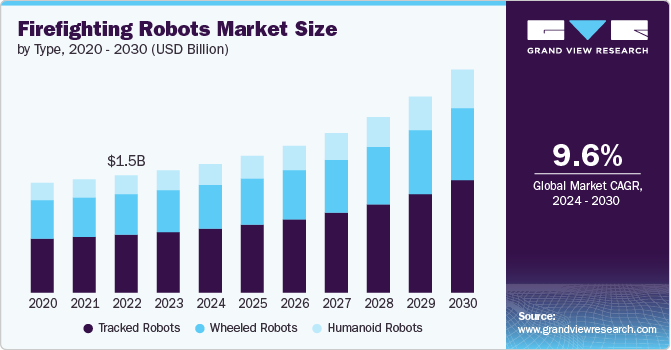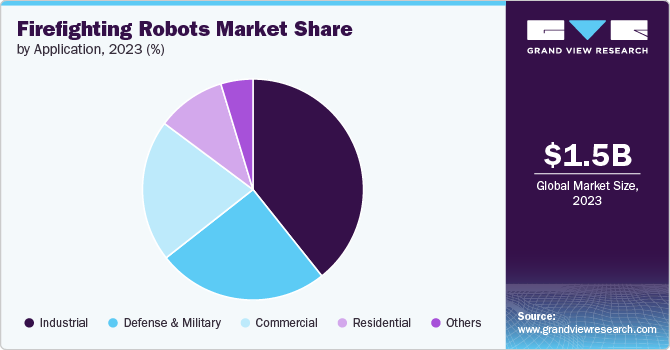
Firefighting Robots Market Size, Share & Trends Analysis Report By Type, By Application (Residential, Commercial, Industrial, Defense & Military), By Region, And Segment Forecasts, 2024 - 2030
- Report ID: GVR-4-68040-464-3
- Number of Report Pages: 130
- Format: PDF
- Historical Range: 2018 - 2022
- Forecast Period: 2024 - 2030
- Industry: Technology
Firefighting Robots Market Size & Trends
The global firefighting robots market was estimated at USD 1.53 billion in 2023 and is projected to grow at a CAGR of 9.6% from 2024 to 2030. The increasing incidents of industrial fires and hazardous situations drive the market's growth. Industrial sectors such as oil and gas, chemical manufacturing, power generation, and mining often operate in environments where the risk of fire is high. These industries deal with highly flammable materials, pressurized gases, and high-temperature machinery, making them prone to accidents that can quickly escalate into large-scale fires.

Traditional firefighting methods involving human firefighters may not be feasible or safe in such hazardous conditions. The heat, smoke, toxic fumes, or explosive materials often make it too dangerous for people to approach the fire. Firefighting robots are designed to withstand extreme conditions, allowing them to suppress fires in inaccessible environments that are too risky for human intervention.
The rising adoption in defense and military operations drives market growth. The defense and military sectors are increasingly adopting firefighting robots for their ability to operate in high-risk environments such as battlefields and military installations. These robots can handle explosive materials, suppress fires in ammunition depots, and manage fires caused by combat operations. The military's focus on developing autonomous systems for safety and operational efficiency drives investments in firefighting robots.
The trend toward automation and the development of smart cities is also driving the market growth. As urban areas become more densely populated and technologically advanced, there is a growing need for automated systems that can quickly respond to emergencies, including fires. Firefighting robots are being integrated into smart city frameworks, where they can be deployed autonomously to respond to fire incidents in residential and commercial areas. The concept of smart cities emphasizes intelligent systems for public safety, and firefighting robots fit seamlessly into this vision by offering efficient and rapid-fire suppression capabilities.
Despite advancements, firefighting robots still face significant technological hurdles. Challenges include limitations in battery life, mobility in difficult terrains, and real-time decision-making capabilities in unpredictable fire environments. Many robots struggle to navigate through debris, extreme heat, or smoke, which can interfere with sensor accuracy and operational efficiency.
Type Insights
Based on type, the tracked robots segment led the market with the largest revenue share of 49.60% in 2023. The tracked robots segment's growth is driven by its ability to operate in extreme conditions. These robots are designed to withstand extreme heat, smoke, and hazardous environments, making them highly valuable in firefighting situations. They are often equipped with heat-resistant materials and advanced sensors that allow them to operate safely in conditions that are dangerous or inaccessible to human firefighters.
The humanoid robots segment is projected to grow at a significant CAGR from 2024 to 2030. Humanoid robots' ability to replicate human movements and perform tasks that would otherwise require human intervention drives the market's growth. Humanoid robots can navigate through tight spaces, climb stairs, open doors, and manipulate objects precisely. These capabilities are essential in fire rescue operations inside buildings, industrial sites, and hazardous areas. This human-like flexibility makes them ideal for accessing areas that traditional robots with wheels or tracks may struggle to reach.
Application Insights
Based on application, the industrial segment led the market with the largest revenue share of 39.3% in 2023. The increasing demand for automation in industrial operations drives the market's growth. Firefighting robots can operate autonomously or be remotely controlled, allowing them to respond to fires quickly and efficiently. In industrial facilities where manual intervention can be slow or dangerous, robotic systems ensure that firefighting efforts are initiated promptly, reducing the likelihood of extensive damage.

The residential segment is projected to grow at a significant CAGR from 2024 to 2030. Urbanization and the growth of high-density residential areas such as apartment complexes and condominiums contribute to the demand for firefighting robots in residential applications. In densely populated areas, the risk of fire spreading between units is higher, and traditional firefighting methods may be slower or less effective. Firefighting robots can offer an immediate response within residential complexes, reducing the potential damage and risk to residents in these environments.
Regional Insights
North America dominated the firefighting robots market with the largest revenue share of 35.2% in 2023. The increasing incidence of large-scale wildfires in North America, particularly in the western U.S. and parts of Canada, drives the market's growth. Due to climate change and other environmental factors, wildfires have become more frequent and intense, posing severe challenges to traditional firefighting methods.
U.S. Firefighting Robots Market Trends
The firefighting robots market in U.S. is expected to grow at a significant CAGR from 2024 to 2030. The growing emphasis on improving fire safety in various sectors, including residential, commercial, and industrial, is fueling the demand for firefighting robots in the U.S. High-profile incidents, such as large-scale fires and disasters, have heightened awareness of the need for advanced fire suppression solutions.
Europe Firefighting Robots Market Trends
The firefighting robots market in Europe is expected to witness at a notable CAGR from 2024 to 2030. Many European countries have strict building codes and continuously updated fire safety standards to improve protection and efficiency. These regulations often encourage or mandate advanced technologies to enhance fire safety and response capabilities. As a result, there is a growing demand for innovative solutions, such as firefighting robots that can meet these stringent standards and provide enhanced fire protection.
Asia Pacific Firefighting Robots Market Trends
The firefighting robots market in Asia Pacific held a significant share of the global market. Rapid urbanization and infrastructure development drive the market's growth. As cities expand and new urban areas are developed, the demand for firefighting robot solutions grows correspondingly. Rapid urbanization leads to new residential, commercial, and industrial zones requiring effective firefighting robots to ensure safety and functionality.
Key Firefighting Robots Company Insights
Key players operating in the market include Howe & Howe; Shark Robotics; Angatec; MITSUBISHI HEAVY INDUSTRIES, LTD.; Vimal Fire; EmiControls; DOK-ING d.o.o.; Shandong Guoxing Intelligent Technology Co., Ltd; QinetiQ; and Ryland Research Limited. The companies are focusing on various strategic initiatives, including new product development and launch, to enhance their market position, meet evolving customer demands, and capitalize on emerging technological advancements in the global market.
Key Firefighting Robots Companies:
The following are the leading companies in the firefighting robots market. These companies collectively hold the largest market share and dictate industry trends.
- Howe & Howe
- Shark Robotics
- Angatec
- MITSUBISHI HEAVY INDUSTRIES, LTD.
- Vimal Fire
- EmiControls
- DOK-ING d.o.o.
- Shandong Guoxing Intelligent Technology Co., Ltd
- QinetiQ
- Ryland Research Limited
Recent Developments
-
In May 2023, FFBOTS, a Dubai manufacturing company, launched Wabel, the first locally made firefighting robot in the Middle East. It is designed to enhance firefighting operations and improve safety for first responders. Wabel can be remotely controlled from up to 1 kilometer away and boasts a powerful water flow rate of 8,000 liters per minute, enabling it to tackle fires effectively
Firefighting Robots Market Report Scope
|
Report Attribute |
Details |
|
Market size value in 2024 |
USD 1.61 billion |
|
Revenue forecast in 2030 |
USD 2.80 billion |
|
Growth rate |
CAGR of 9.6% from 2024 to 2030 |
|
Base year for estimation |
2023 |
|
Historical data |
2018 - 2022 |
|
Forecast period |
2024 - 2030 |
|
Quantitative units |
Revenue in USD million/billion and CAGR from 2024 to 2030 |
|
Report coverage |
Revenue forecast, company market share, competitive landscape, growth factors, and trends |
|
Segments covered |
Type, application, region |
|
Regional scope |
North America; Europe; Asia Pacific; Latin America; Middle East & Africa |
|
Country scope |
U.S.; Canada; Mexico; UK; Germany; France; China; India; Japan; South Korea; Australia; Brazil; Kingdom of Saudi Arabia (KSA); UAE; South Africa |
|
Key companies profiled |
Howe & Howe; Shark Robotics; Angatec; MITSUBISHI HEAVY INDUSTRIES, LTD.; Vimal Fire; EmiControls; DOK-ING d.o.o.; Shandong Guoxing Intelligent Technology Co., Ltd; QinetiQ; Ryland Research Limited |
|
Customization scope |
Free report customization (equivalent to up to 8 analyst’s working days) with purchase. Addition or alteration to country, regional, and segment scope |
|
Pricing and purchase options |
Avail customized purchase options to meet your exact research needs. Explore purchase options |
Global Firefighting Robots Market Report Segmentation
The report forecasts revenue growth at global, regional, and country levels and provides an analysis of the latest industry trends in each of the sub-segments from 2018 to 2030. For this study, Grand View Research has segmented the global firefighting robots market based on type, application, and region.

-
Type Outlook (Revenue, USD Million, 2018 - 2030)
-
Humanoid Robots
-
Tracked Robots
-
Wheeled Robots
-
-
Application Outlook (Revenue, USD Million, 2018 - 2030)
-
Residential
-
Commercial
-
Industrial
-
Defense & Military
-
Others
-
-
Regional Outlook (Revenue, USD Million, 2018 - 2030)
-
North America
-
U.S.
-
Canada
-
Mexico
-
-
Europe
-
Germany
-
UK
-
France
-
-
Asia Pacific
-
China
-
India
-
Japan
-
Australia
-
South Korea
-
-
Latin America
-
Brazil
-
-
Middle East & Africa
-
UAE
-
Kingdom of Saudi Arabia
-
South Africa
-
-
Frequently Asked Questions About This Report
b. The global firefighting robots market size was estimated at USD 1.53 billion in 2023 and is expected to reach USD 1.61 billion in 2024.
b. The global firefighting robots market is expected to grow at a compound annual growth rate of 9.6% from 2024 to 2030 to reach USD 2.80 billion by 2030.
b. North America dominated the firefighting robots market with a share of 35.2% in 2023. The increasing incidence of large-scale wildfires in North America, particularly in the western U.S. and parts of Canada, drives the regional market's growth.
b. Some key players operating in the firefighting robots market include Howe & Howe; Shark Robotics; Angatec; MITSUBISHI HEAVY INDUSTRIES, LTD.; Vimal Fire; EmiControls; DOK-ING d.o.o.; Shandong Guoxing Intelligent Technology Co.,Ltd; QinetiQ; and Ryland Research Limited.
b. Key factors that are driving the market growth include the rising adoption of automation in fire safety and the growing frequency of fire-related incidents.
We are committed towards customer satisfaction, and quality service.
"The quality of research they have done for us has been excellent."




